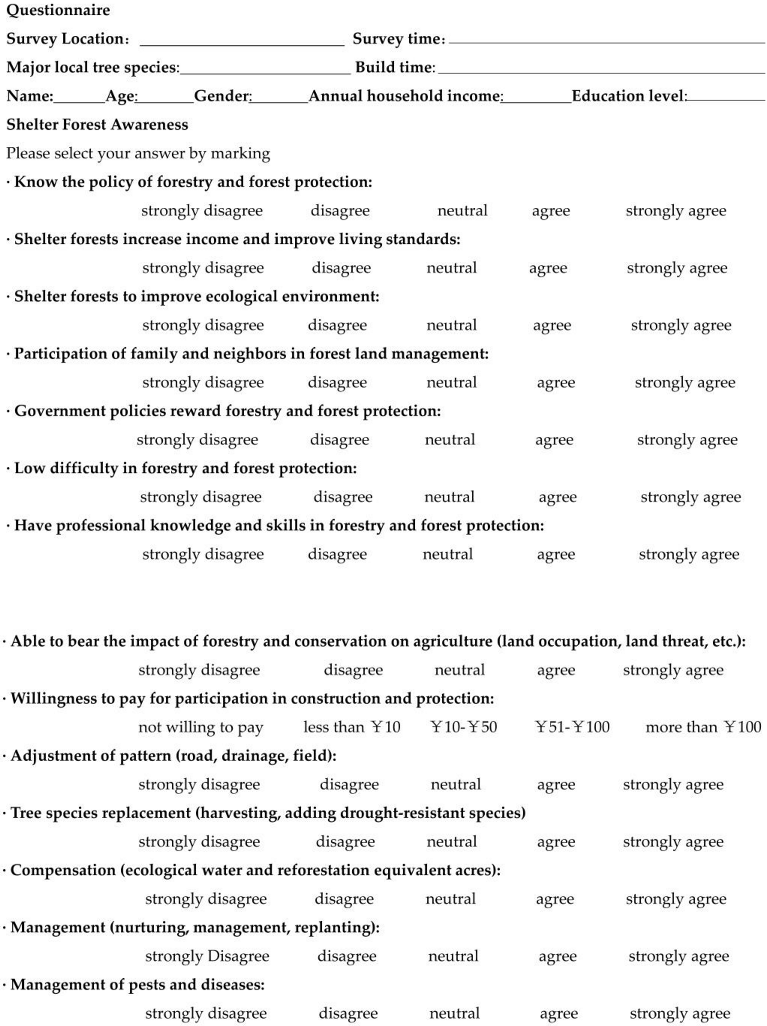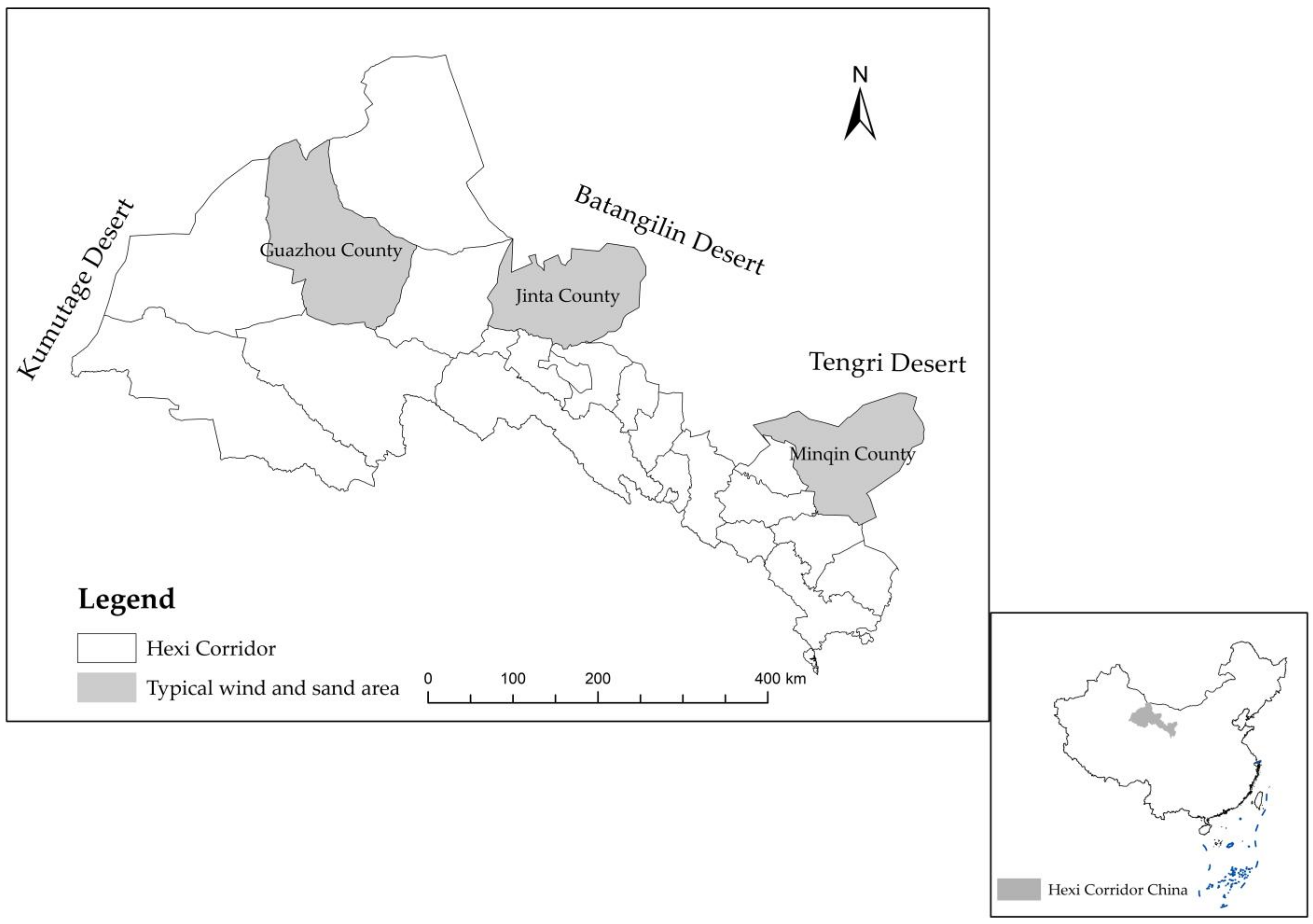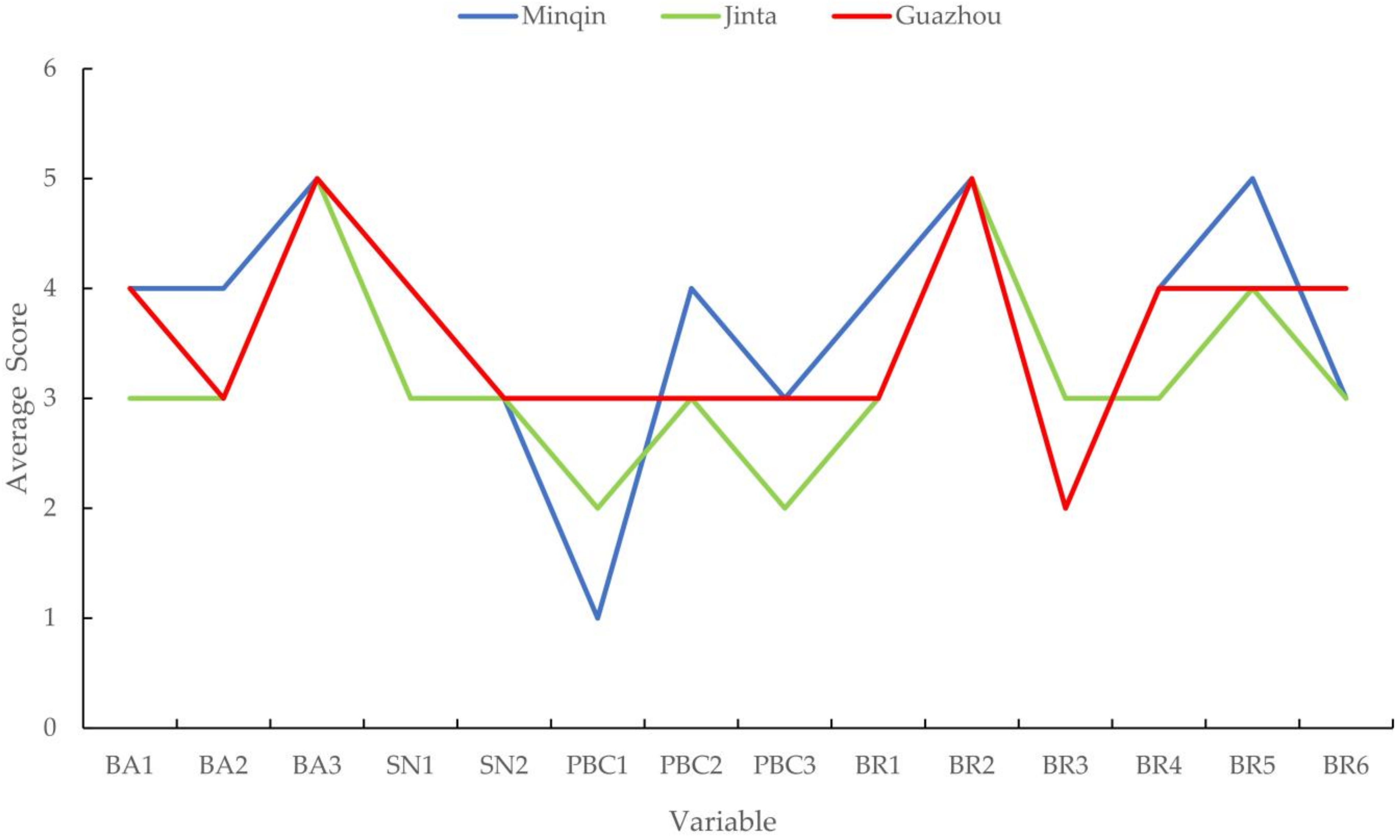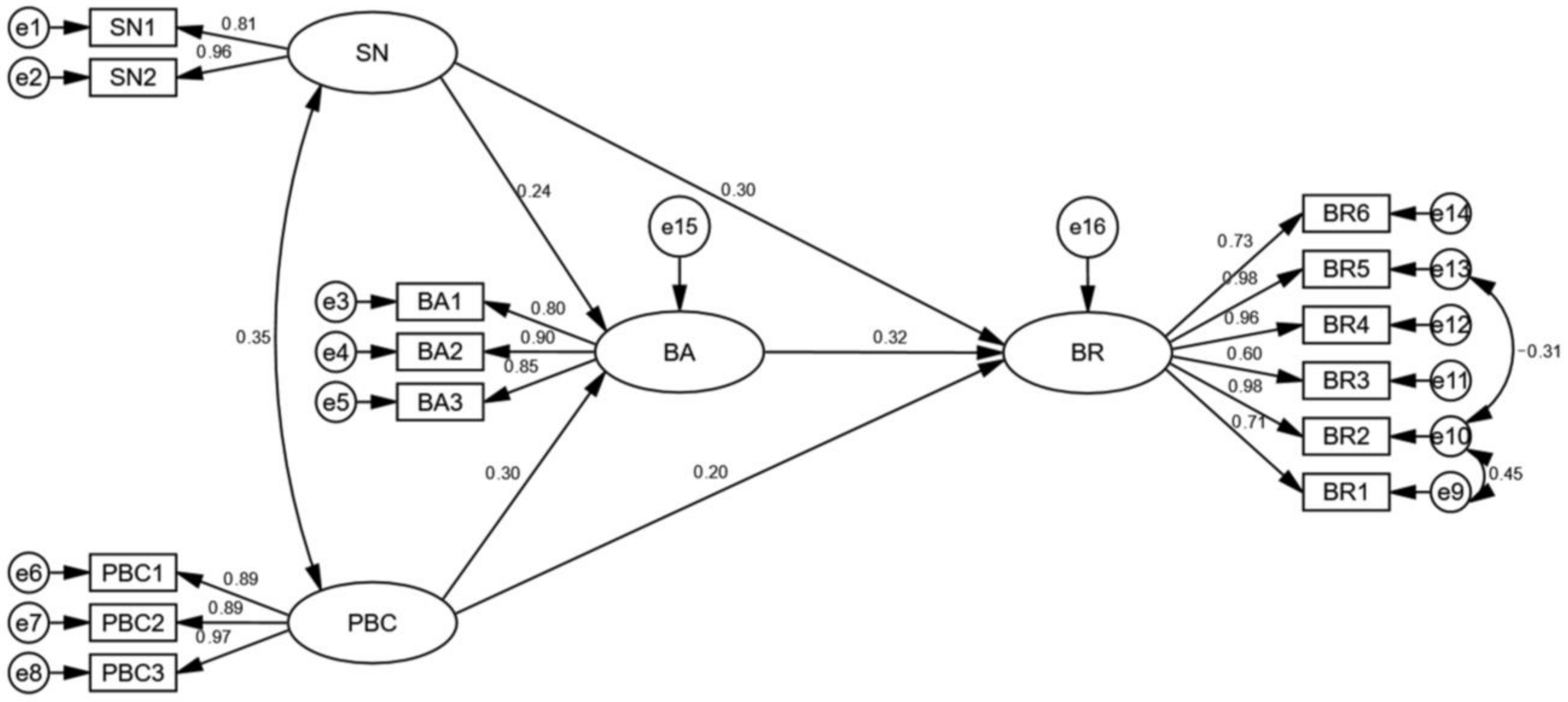Study on Sustainability of Shelter Forest Construction and Protection Behavior of Farmers in the Sandstorm Area of Hexi Corridor, China
Abstract
1. Introduction
2. Materials and Methods
2.1. Study Site
2.2. Theoretical Framework and Research Hypothesis
2.3. Data Source
2.4. Model Construction
2.5. Questionnaire Design Description and Software Analysis
3. Results
3.1. Reliability and Validity Tests
3.2. Model Fitness Check
3.3. Analysis of Empirical Results on the Influence of Farmers’ Perceptions on Shelter Forest Construction and Protection Behavior
4. Discussion and Conclusions
4.1. Discussion
4.2. Conclusions
Author Contributions
Funding
Informed Consent Statement
Data Availability Statement
Acknowledgments
Conflicts of Interest
Appendix A

References
- Ma, C.Y.; Tang, L.B.; Chang, W.Q.; Jaffar, M.T.; Zhang, J.G.; Li, X.; Chang, Q.; Fan, J.L. Effect of Shelterbelt Construction on Soil Water Characteristic Curves in an Extreme Arid Shifting Desert. Water 2022, 14, 1803. [Google Scholar] [CrossRef]
- Marais, Z.E.; Baker, T.P.; Hunt, M.A.; Mendham, D. Shelterbelt species composition and age determine structure: Consequences for ecosystem services. Agric. Ecosyst. Environ. 2022, 329, 107884. [Google Scholar] [CrossRef]
- Li, H.L.; Wang, Y.D.; Li, S.Y.; Askar, A.; Wang, H.F. Shelter Efficiency of Various Shelterbelt Configurations: A Wind Tunnel Study. Atmosphere 2022, 13, 1022. [Google Scholar] [CrossRef]
- Nakahama, N.; Hayamizu, M.; Iwasaki, K.; Nitta, N. Management and landscape of shelterbelts contribute to butterfly and flowering plant diversity in northern Japan. Ecol. Res. 2022, 37, 780–790. [Google Scholar] [CrossRef]
- Zhai, J.J.; Wang, L.; Liu, Y.; Wang, C.Y.; Mao, X.G. Assessing the effects of China’s Three-North Shelter Forest Program over 40 years. Sci. Total Environ. 2022, 857, 159354. [Google Scholar] [CrossRef] [PubMed]
- Mu, H.W.; Li, X.C.; Ma, H.J.; Du, X.P.; Huang, J.X.; Su, W.; Yu, Z.; Xu, C.; Liu, H.L.; Yin, D.Q.; et al. Evaluation of the policy-driven ecological network in the Three-North Shelterbelt region of China. Landsc. Urban Plan. 2022, 218, 10435. [Google Scholar] [CrossRef]
- Liang, X.Y.; Xin, Z.B.; Shen, H.Y.; Yan, T.F. Deep soil water deficit causes Populus simonii Carr degradation in the three north shelterbelt region of China. J. Hydrol. 2022, 612, 128201. [Google Scholar] [CrossRef]
- Li, X.N.; Wang, H.; Qin, S.H.; Li, Y.T.; Meng, P.Y.; Song, Z.L.; Wang, Y.C.; Yang, Y. Yellow river delta shelter forest dynamic and degradation factors detection in different phenophases. Plant Soil 2022, 479, 233–250. [Google Scholar] [CrossRef]
- Zhang, H.; Kuuluvainen, J.; Yang, H.Q.; Xie, Y.; Liu, C. The Effect of Off-Farm Employment on Forestland Transfers in China: A Simultaneous-Equation Tobit Model Estimation. Sustainability 2017, 9, 1645. [Google Scholar] [CrossRef]
- Vladimir, S. Policy Processes in the Institutionalisation of Private Forestry in the Republic of North Macedonia. Sustainability 2022, 14, 4018. [Google Scholar]
- Starr, S.E.; McConnell, T.E. Changes in Ohio Tree Farmers’ Forest Management Strategies and Outreach Needs. For. Sci. 2014, 60, 811–816. [Google Scholar] [CrossRef]
- Ndayambaje, J.D.; Heijman, W.J.; Mohren, G.M.J. Household Determinants of Tree Planting on Farms in Rural Rwanda. Small Scale For. 2012, 11, 477–508. [Google Scholar] [CrossRef]
- Godoy, C.C.N.; Pienaar, E.F.; Branch, L.C. Willingness of private landowners to participate in forest conservation in the Chaco region of Argentina. For. Policy Econ. 2022, 138, 102708. [Google Scholar] [CrossRef]
- Shao, W.Y.; Wang, Q.Z.; Guan, Q.Y.; Zhang, J.; Yang, X.Y.; Liu, Z. Environmental sensitivity assessment of land desertification in the Hexi Corridor, China. Catena 2023, 220, 106728. [Google Scholar] [CrossRef]
- Dong, Z.B.; Lv, P.; Qian, G.Q.; Xia, X.C.; Zhao, Y.J.; Mu, G.J. Research progress in China’s Lop Nur. Earth Sci. Rev. 2012, 111, 142–153. [Google Scholar] [CrossRef]
- Zhang, T.T.; Shao, Y.; Geng, Y.Y.; Gong, H.Z.; Yang, L. A study on historical location and evolution of Lop Nor in China with maps and DEM. J. Arid. Land 2021, 13, 639–652. [Google Scholar] [CrossRef]
- Ajzen, I. The theory of planned behaviour. Organ. Behav. Hum. Decis. Process. 1991, 50, 179–211. [Google Scholar] [CrossRef]
- Ajzen, I.; Fishbein, M. Understanding Attitudes and Predicting Social Behavior; Prentice-Hall: Englewood Cliffs, NJ, USA, 1980. [Google Scholar]
- Ajzen, I.; Madden, T.J. Prediction of goal-directed behaviour: Attitude, intentions, and perceived behavioural control. J. Exp. Soc. Psychol. 1986, 22, 453–474. [Google Scholar] [CrossRef]
- Shi, H.T.; Wang, Z.Y.; Yan, L. The Influence of Ecological Cognition on Farmers’ Grain for Green Behavior: Based on TPB and Multi-group SEM. China Land Sci. 2019, 33, 42–49. [Google Scholar]
- Karppinen, H. Forest owners’ choice of reforestation method: An application of the theory of planned behavior. For. Policy Econ. 2005, 7, 393–409. [Google Scholar] [CrossRef]
- Wang, J.H.; Chu, M.; Deng, Y.Y.; Lam, H.M.; Tang, J.J. Determinants of pesticide application: An empirical analysis with theory of planned behaviour. China Agric. Econ. Rev. 2018, 10, 608–625. [Google Scholar] [CrossRef]
- Meijer, S.S.; Catacutan, D.; Sileshi, G.W.; Nieuwenhuis, M. Tree planting by smallholder farmers in Malawi: Using the theory of planned behaviour to examine the relationship between attitudes and behaviour. J. Environ. Psychol. 2015, 43, 1–12. [Google Scholar] [CrossRef]
- Jin, L.S.; Xu, K.; Pang, J. Impact of Ecological Cognition on Farmer’s Willingness and Behavior of Participating Sloping Land Conversion Program: Based on Survey Data from Two Poverty-Stricken Counties in Yunnan Province. J. Agro For. Econ. Manag. 2020, 19, 716–725. [Google Scholar]
- Bossange, A.V.; Knudson, K.M.; Shrestha, A.; Harben, R.; Mitchell, J.P. The Potential for Conservation Tillage Adoption in the San Joaquin Valley, California: A Qualitative Study of Farmer Perspectives and Opportunities for Extension. PLoS ONE 2016, 11, e0167612. [Google Scholar] [CrossRef] [PubMed]
- Mutyasira, V.; Hoag, D.; Pendell, D. The adoption of sustainable agricultural practices by smallholder farmers in Ethiopian highlands: An integrative approach. Cogent Food Agric. 2018, 4, 1552439. [Google Scholar] [CrossRef]
- Wen, N.; Zhang, H.L. Analysis on the factors influencing farmers’ farmland shelterbelt management willingness and behavior deviation in Xinjiang. J. Arid. Land Resour. Environ. 2020, 34, 59–64. [Google Scholar]
- Boz, I. Determinants of farmers’ enrollment in voluntary environmental programs: Evidence from the Eregli Reed Bed area of Turkey. Environ. Dev. Sustain. 2018, 20, 2643–2661. [Google Scholar] [CrossRef]
- Lou, S.; Zhang, B.; Zhang, D. Foresight from the hometown of green tea in China: Tea farmers’ adoption of pro-green control technology for tea plant pests. J. Clean. Prod. 2021, 320, 128817. [Google Scholar] [CrossRef]
- Empidi, A.V.A.; Emang, D. Understanding Public Intentions to Participate in Protection Initiatives for Forested Watershed Areas Using the Theory of Planned Behavior: A Case Study of Cameron Highlands in Pahang, Malaysia. Sustainability 2021, 13, 4399. [Google Scholar] [CrossRef]
- Petty, R.E.; Cacioppo, J.T. Attitudes and Persuasion: Classic and Contemporary Approaches; Routledge: New York, NY, USA, 2019. [Google Scholar]
- Quintal, V.A.; Lee, J.A.; Soutar, G.N. Risk, uncertainty and the theory of planned behavior: A tourism example. Tour. Manag. 2010, 31, 797–805. [Google Scholar] [CrossRef]
- Daxini, A.; Ryan, M.; O’Donoghue, C.; Barnes, A.P. Understanding farmers’ intentions to follow a nutrient management plan using the theory of planned behaviour. Land Use Policy 2019, 85, 428–437. [Google Scholar] [CrossRef]
- Maleksaeidi, H.; Ranjbar, S.; Eskandari, F.; Jalali, M.; Keshavarz, M. Vegetable farmers’ knowledge, attitude and drivers regarding untreated wastewater irrigation in developing countries: A case study in Iran. J. Clean. Prod. 2018, 202, 863–870. [Google Scholar] [CrossRef]
- Rezaei, R.; Ghofranfarid, M. Rural households’ renewable energy usage intention in Iran: Extending the unified theory of acceptance and use of technology. Renew. Energy 2018, 122, 382–391. [Google Scholar] [CrossRef]
- Chen, Q.R. Analyzing Farmers’ Cultivated-Land-Abandonment Behavior: Integrating the Theory of Planned Behavior and a Structural Equation Model. Land 2022, 11, 1777. [Google Scholar] [CrossRef]
- Rampedi, I.T.; Ifegbesan, A.P. Understanding the Determinants of Pro-Environmental Behavior among South Africans: Evidence from a Structural Equation Model. Sustainability 2022, 14, 3218. [Google Scholar] [CrossRef]
- Xu, Z.M. Theoretical Methods and Applications of Ecological Economics; Yellow River Water Conservancy Press: Zhengzhou, China, 2003. [Google Scholar]
- Collier, J.E. Applied Structural Equation Modeling Using AMOS: Basic to Advanced Techniques; Taylor and Francis: Abingdon, UK, 2020. [Google Scholar]
- Okello, G.O. Simplified Business Statistics Using SPSS; CRC Press: Boca Raton, FL, USA, 2022. [Google Scholar]
- Wu, M.L. Structural Equation Modeling: Operations and Applications of AMOS; Chongqing University Press: Chongqing, China, 2009; pp. 41–42. [Google Scholar]
- Cheng, L.L.; Guo, H.; Lu, Q. Review on the Valuation of Desert Ecosystem Service Values. J. Desert Res. 2013, 33, 281–287. [Google Scholar]
- Tang, Q. The Importance of Ecosystem Service Oasis-Desert Ecotone and Its Impact on Farmers’ We11-Being—A Case of Shapotou; Lanzhou University: Lanzhou, China, 2017. [Google Scholar]
- Cao, L.F.; Zeng, Y.L.; Song, X. Effects of forest rights restriction and ecological compensation on the forestry management and conservation behavior of farmers in public welfare forests: Based on seven consecutive years of observational data in Hunan Province. Rural. Econ. 2020, 447, 112–119. [Google Scholar]
- Zhi, L.; Zhang, Y.; Xie, Y.M.; Long, Q.; Guo, X.N. Analysis on Farmers’ Accepting Willingness of Ecological Compensation of Non-commercial Forest in NFPP Area of China Taking six western counties as an example. In Proceedings of the 2nd 2016 International Conference on Sustainable Development (ICSD 2016), Xi’an, China, 2–4 December 2016; pp. 474–479. [Google Scholar]




| Sample Counties | Minqin | Jinta | Guazhou |
|---|---|---|---|
| Town/Village | 10/22 | 7/16 | 10/26 |
| Variable | Category | N | % |
|---|---|---|---|
| Gender | Male | 501 | 77 |
| Female | 419 | 23 | |
| Age Group | 0–40 | 48 | 7.4 |
| 41–60 | 427 | 65.7 | |
| 61–75 | 175 | 26.9 | |
| Education level | Primary School | 187 | 28.75 |
| Junior High School | 313 | 48.21 | |
| High School | 150 | 23.04 | |
| Annual household income | ≤CNY 20,000 (≤USD 2912) | 48 | 7.36 |
| CNY 20,001–40,000 (USD 2912–5824) | 302 | 46.56 | |
| CNY 40,001–60,000 (USD 5824–8736) | 218 | 33.49 | |
| >CNY 60,000 (>USD 8736) | 82 | 12.59 |
| Latent Variable | No. | Test Items | Average | Standard Deviation |
|---|---|---|---|---|
| Behavioral attitude | BA1 | Knowing the policy of forest construction and protection | 3.625 | 0.805 |
| BA2 | Shelter forests increase income and improve living standards | 4.018 | 0.724 | |
| BA3 | Shelter forest to improve the ecological environment | 4.285 | 0.846 | |
| Subjective norms | SN1 | Participation of family and neighbors in the management of forest land | 3.762 | 0.715 |
| SN2 | Government policy rewards forestry and conservation practices | 3.577 | 0.973 | |
| Perceptual behavior control | PBC1 | Little difficulty in constructing forests and protecting them | 2.903 | 0.908 |
| PBC2 | Acquire professional knowledge and skills in forestry and forest protection | 3.283 | 0.902 | |
| PBC3 | Able to assume the impact of forestation and conservation on agriculture | 3.192 | 0.962 | |
| Behavioral Response | BR1 | Willingness to pay for participation in construction and protection | 3.780 | 0.960 |
| BR2 | Compensation | 3.926 | 0.749 | |
| BR3 | Replacement tree species | 3.420 | 0.907 | |
| BR4 | Management of pests and diseases | 4.143 | 0.829 | |
| BR5 | Management | 4.185 | 0.860 | |
| BR6 | Adjusting the pattern | 4.038 | 0.904 |
| Latent Variable | Observed Variables | Crombach’s α | KMO | Bartlett’s Test | Factor Load |
|---|---|---|---|---|---|
| BA | BA1 | 0.882 | 0.856 | 7791.371 (0.000) | 0.830 |
| BA2 | 0.872 | ||||
| BA3 | 0.866 | ||||
| SN | SN1 | 0.852 | 0.906 | ||
| SN2 | 0.892 | ||||
| PBC | PBC1 | 0.942 | 0.919 | ||
| PBC2 | 0.885 | ||||
| PBC3 | 0.916 | ||||
| BR | BR1 | 0.915 | 0.731 | ||
| BR2 | 0.781 | ||||
| BR3 | 0.700 | ||||
| BR4 | 0.875 | ||||
| BR5 | 0.867 | ||||
| BR6 | 0.789 |
| Measurement Models | Model Inclusion Factors | X2 | df | RMSEA | CFI | TLI | ∆X2 | Note |
|---|---|---|---|---|---|---|---|---|
| a. Single factor | BA + PBC + SN + BR | 3536.351 | 77 | 0.263 | 0.555 | 0.474 | ||
| b. Two factors | BA + PBC, SN + BR | 2165.313 | 76 | 0.206 | 0.731 | 0.678 | 1371.038 *** | Compared to a |
| c. Three factors | BA + PBC, SN, BR | 1648.243 | 74 | 0.181 | 0.797 | 0.751 | 517.07 *** | Compared to b |
| d. Four Factors | BA, PBC, SN, BR | 588.688 | 71 | 0.105 | 0.933 | 0.915 | 1059.555 *** | Compared to c |
| Overall Model Suitability Index | Statistical Test Value | Estimated Value | Recommended Value | Fitting Results |
|---|---|---|---|---|
| Absolute Index | x2/df | 4.803 | <5.00 | Qualified |
| GFI | 0.938 | >0.90 | Ideal | |
| RMSEA | 0.077 | <0.10 | Ideal | |
| Value Added Index | NFI | 0.961 | > 0.90 | Ideal |
| RFI | 0.944 | >0.90 | Ideal | |
| CFI | 0.969 | >0.90 | Ideal | |
| Simplicity index | PGFI | 0.572 | >0.50 | Ideal |
| PNFI | 0.676 | >0.50 | Ideal |
| Hypothetical | Path | Estimate | S.E. | P | Results |
|---|---|---|---|---|---|
| H1 | BA→BR | 0.337 | 0.04 | *** | Establish |
| H2 | SN→BR | 0.216 | 0.028 | *** | Establish |
| H3 | PBC→BR | 0.170 | 0.029 | *** | Establish |
| H4 | SN→BA | 0.164 | 0.031 | *** | Establish |
| H5 | PBC→BA | 0.242 | 0.034 | *** | Establish |
Disclaimer/Publisher’s Note: The statements, opinions and data contained in all publications are solely those of the individual author(s) and contributor(s) and not of MDPI and/or the editor(s). MDPI and/or the editor(s) disclaim responsibility for any injury to people or property resulting from any ideas, methods, instructions or products referred to in the content. |
© 2023 by the authors. Licensee MDPI, Basel, Switzerland. This article is an open access article distributed under the terms and conditions of the Creative Commons Attribution (CC BY) license (https://creativecommons.org/licenses/by/4.0/).
Share and Cite
Zhang, Y.; Xu, X.; Liu, H.; Wang, L.; Niu, D. Study on Sustainability of Shelter Forest Construction and Protection Behavior of Farmers in the Sandstorm Area of Hexi Corridor, China. Sustainability 2023, 15, 5242. https://doi.org/10.3390/su15065242
Zhang Y, Xu X, Liu H, Wang L, Niu D. Study on Sustainability of Shelter Forest Construction and Protection Behavior of Farmers in the Sandstorm Area of Hexi Corridor, China. Sustainability. 2023; 15(6):5242. https://doi.org/10.3390/su15065242
Chicago/Turabian StyleZhang, Yuzhong, Xianying Xu, Hujun Liu, Li Wang, and Danni Niu. 2023. "Study on Sustainability of Shelter Forest Construction and Protection Behavior of Farmers in the Sandstorm Area of Hexi Corridor, China" Sustainability 15, no. 6: 5242. https://doi.org/10.3390/su15065242
APA StyleZhang, Y., Xu, X., Liu, H., Wang, L., & Niu, D. (2023). Study on Sustainability of Shelter Forest Construction and Protection Behavior of Farmers in the Sandstorm Area of Hexi Corridor, China. Sustainability, 15(6), 5242. https://doi.org/10.3390/su15065242





